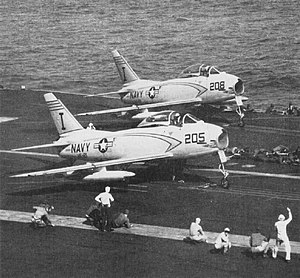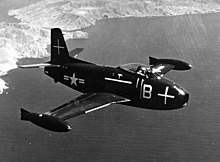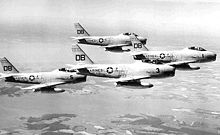North American FJ
| North American FJ Fury | |
|---|---|
 FJ-3 of VF-21 on USS Forrestal 1956 |
|
| Type: | Fighter plane and fighter-bomber |
| Design country: | |
| Manufacturer: | |
| First flight: |
|
| Commissioning: |
1947 |
| Production time: |
1947 to 1958 |
| Number of pieces: |
|
The North American FJ Fury was the first operational carrier based jet aircraft of the US Navy and the US Marine Corps , which as a fighter and fighter-bomber was used. In 1962 the FJ was renamed the F-1 .
history
The war in the Pacific was still in full swing when, between the fall of 1944 and the spring of 1945, the US Navy ordered four prototypes of a carrier-based jet aircraft in the hope that these would be available for the planned May 1946 invasion of Japan. These were the Vought F6U Pirate , the McDonnell FD Phantom , the McDonnell F2D Banshee and the North American FJ Fury .
North American's design, known in-house as NA-134 , was originally conceived as a conventional low-wing aircraft with straight wings and a relatively thick fuselage cross-section. For better all-round visibility, the cockpit was designed in the shape of drops (similar to the P-51 Mustang ). A General Electric J35 engine was supplied through a large air intake located in the nose . For the purpose of easily controllable slow flight - essential for carrier landings - narrow, extendable air brakes were attached to the upper and lower sides of the wing.
In the meantime, the US Air Force had opted for a land-based version of the Fury , which was known as the XP-86 and became famous during the Korean War as the F-86 Saber . Although the XP-86 was already equipped with swept wings, North American held on to the FJ-1 on straight wings, as these seemed indispensable for carrier deck landings due to their better slow flight characteristics. The Navy ordered three prototypes called the XFJ-1 . In April 1945 a mock-up was examined by the Bureau of Aeronautics and on September 11, 1946, the first XFJ-1 took off on its maiden flight. The second and third prototype followed in October 1946 and February 1947.
Versions
FJ-1
The Navy had already ordered 100 FJ-1 machines in May 1945, but later reduced this order to 30 machines. This version, known in-house as NA-141 , was delivered to the troops from October 1947. In contrast to the originally proposed prototype, the FJ-1 had only two retractable air brakes housed in the wings instead of the four, but they were much larger and were located in the rear fuselage sides. She also had a smaller nose gear, which should make parking on the carrier deck easier.
All machines went to the VF-5A Fighter Squadron on NAS North Island, which immediately began with initially simulated carrier take-offs and landings. Then on March 16, 1948, the first real carrier landing on board the USS Boxer took place. After the two successfully landed machines started again on their own (!), Two starts followed with the help of a catapult. However, when it became clear that a self-propelled take-off would increase the take-off distance due to the low acceleration, it was decided to introduce the catapult launch procedure as the standard.
The pilots of the VF-5A were very satisfied with the flight performance of the FJ-1, having won the Bendix Trophy in 1948 , in which they clearly defeated the F-80 Shooting Star of the US Air Force during an overland flight .
In addition to this success, however, there was also criticism. With maximum payload, the FJ-1 was difficult to control in the air, and the pilot was not to be envied due to the lack of pressure compensation and high temperatures in the cockpit. Another shortcoming was the 630 liter additional tanks attached to the wing tips, which were not suitable for the thin wing cross-sections. The engine's short maintenance interval of just 30 hours was also a disadvantage. Due to the sometimes hard landings during training and crashes due to a lack of fuel, more than half of the FJ-1 had to be written off by the end of their service life.
In August 1948 the VF-5A was renamed the VF-51. After the F9F-2 Panther was introduced here from July 1949 , the remaining FJ-1s went to the US Navy Reserve, where they were used as jet trainers for retraining on the F9F Panther and the F2H Banshee until early 1953 .
FJ-2
Based on the opinion that carrier-based jet aircraft automatically had to have straight wings due to low landing approach speeds, the US Navy for a long time resisted new designs. In the meantime, however, it had been found that these very models (F9F Panther and F2H Banshee ) were considerably slower than their arrow-winged competitors (e.g. the MiG-15 ) at their top speed .
Since the beginning of 1951, North American had started to develop a carrier-supported version of the now proven F-86 Saber . Less than two weeks later, the US Navy ordered 300 machines of this type unseen. However, the order was later reduced to 200 machines.
The FJ-2 was largely based on the land-based F-86E . However, it also had a V-shaped catch hook under the fuselage stern as well as an extended nose landing gear and catapult locks. However, the first two prototypes XF-J2 ( NA-179 ) had neither armament nor folding wings.
The third prototype XFJ-2B ( NA-181 ) was equipped with four 20 mm automatic cannons of the type Colt MK 12. All three prototypes had the General Electric J47-GE-13 engine. The maiden flight took place on December 27, 1951, and from December 1952 the first carrier landings on board the USS Coral Sea took place . However, these revealed difficulties both with the landing gear and a too weak catch hook as well as with the flight behavior during the take-off and landing phase.
Although extremely dissatisfied with the characteristics of the XFJ-2, the Navy stuck to its orders for the FJ-2, but with a new engine, the General Electric J47-GE-2 , whose performance was equivalent to that of the F-86F .
Due to the inadequate performance for operation on aircraft carriers, the FJ-2 went exclusively to the Marine Corps . As the first squadron, the VMF-122 fighter squadron at the MCAS Cherry Point base in North Carolina was equipped with the FJ-2 in January 1954.
FJ-3
The design of a more powerful version ( NA-194 ) began in March 1952. The Wright J65-W-4 , a license from the British Armstrong-Siddeley Sapphire engine, was chosen as the engine. The aircraft had a slightly larger air inlet than the FJ-2. The thrust compared to the FJ-2 (27 kN) was now 37 kN, the Navy ordered a total of 538 machines. The second series of 214 aircraft had the Wright J65-W-4D engine. A total of 17 Navy squadrons and four Marines squadrons flew the FJ-3. As the first squadron, the VF-173 fighter squadron was equipped with the FJ-3 on NAS Jacksonville in Florida. This squadron used the FJ-3 from May 1955 for the first time from an aircraft carrier, the USS Bennington . An FJ-3 was the first aircraft to land on January 4, 1956 on the then new "supercarrier" USS Forrestal .
In 1962, the remaining FJ-3s were renamed F-1C as part of the uniform naming system . With the rapid development of technology, the FJ-3 were modified. Many machines were equipped with two additional under wing stations. 80 FJ-3 were additionally equipped for the use of the AIM-9 Sidewinder air-to-air guided missile and redesignated as FJ-3M (MF-1C). Some FJ-3s were modified as guided aircraft for drones from 1957 to 1960 : the FJ-3D (DF-1C) for SSM-N-8A Regulus missiles and the FJ-3D2 (DF-1D) for unmanned Grumman F9F-6K .
FJ-4
The last version of the "FJ" series - and what most pilots called the best - was probably the FJ-4 (F-1E). It began its career in June 1953 as the prototype NA-208 . The US Navy had previously requested a speed of Mach 0.95 and a (fully loaded) climb of almost 15,000 m, values that at the time could not actually be achieved without the use of an afterburner. From October 1953, the US Navy ordered 152 machines, the last FJ-4 was delivered in March 1957.
The main (also optical) difference to the FJ-3 was a 50% higher internal fuel consumption. This was achieved by an additional tank underneath the Wright J65-W-16A engine as well as an "attached" tank between the cockpit and vertical stabilizer, which made the aircraft appear "bulky" overall. For aerodynamic compensation, the wings were made thinner and shorter, but had a larger wing. Furthermore, the surfaces of the wings, the slats and the landing flaps were completely redesigned. The rudder and horizontal stabilizer were also given a new shape. In addition, there was a fixed air refueling nozzle under the left wing. An AIM-9 Sidewinder air-to-air guided weapon could be carried at each of the four underwing stations . With these changes, the first FJ-4 took off for the first time on October 28, 1954.
The delivery of the NA-209 began in February 1955, but all FJ-4s were delivered to the US Marine Corps, the first squadron was this VMF-451.
FJ-4B
The FJ-4B flew for the first time on December 4, 1956 and was actually "only" the ground attack variant of the FJ-4, but it was built in far higher numbers. If you follow the development of the two "tribes", they contained many components of the F-86H Saber . The FJ-4B had six underwing stations that could carry a total of 2,700 kg of external loads, including additional tanks, missiles and / or bombs, including (optionally) one with a nuclear warhead. As the first Fury , the FJ-4B could carry up to five AGM-12 Bullpup air-to-ground guided missiles.
After further modifications and changes, the now named NA-244 model was delivered between July 1957 and May 1958, a total of 222 aircraft of this type were produced. Two FJ-4Bs were equipped with an additional AR-1 rocket motor for test purposes in 1958.
The FJ-4B was first deployed in 1958 on board the USS Hornet with the VA-214 attack squadron, and was last deployed in 1962 on board the USS Hancock with the VA-216 squadron. A total of nine squadrons of the Navy and three of the Marines flew the FJ-4B. After that, all machines were assigned to reserve units of the US Navy and the US Marine Corps. After the US Department of Defense had decided on a uniform designation of the aircraft stocks, the type FJ-4 in F-1E and the type FJ-4B in AF-1E were renamed from October 1, 1962 . The latter was still in service until the mid-1960s.
production
Acceptance of the North American Fury by the US Navy:
| version | 1947 | 1948 | 1949 | 1950 | 1951 | 1952 | 1953 | 1954 | 1955 | 1956 | 1957 | 1957/58 | TOTAL |
|---|---|---|---|---|---|---|---|---|---|---|---|---|---|
| XAJ-1 | 3 | 3 | |||||||||||
| FJ-1 | 8th | 22nd | 30th | ||||||||||
| FJ-2 | 1 | 24 | 175 | 200 | |||||||||
| FJ-3 | 1 | 103 | 279 | 125 | 508 | ||||||||
| FJ-3M | 30th | 30th | |||||||||||
| FJ-4 | 2 | 17th | 113 | 120 | 152 | ||||||||
| FJ-4B | 1 | 221 | 222 | ||||||||||
| TOTAL | 11 | 22nd | 0 | 0 | 0 | 1 | 25th | 280 | 296 | 269 | 20th | 221 | 1,145 |
Technical specifications
| Parameter | FJ-1 | FJ-3 | FJ-4 | FJ-4B |
|---|---|---|---|---|
| Length: | 10.5 m | 11.5 m | 11.5 m | 11.1 m |
| Span: | 9.8 m | 11.3 m | 11.9 m | 11.9 m |
| Height: | 4.5 m | 4.2 m | 4.2 m | 4.2 m |
| Wing area: | 20.5 m² | k. A. | k. A. | k. A. |
| Empty weight: | 4,011 kg | 5,536 kg | 5,992 kg | 6,250 kg |
| Maximum take-off weight: | 7,076 kg | 9,536 kg | 10,750 kg | 12,700 kg |
| Top speed: | 880 km / h | 1,094 km / h | 1,094 km / h | 1,094 km / h |
| Maximum range: | 2,414 km | 2,870 km | 3,250 km | 3,250 km |
| Service ceiling: | 9,754 m | 10,668 m | 14,300 m | 14,300 m |
| Drive: | Allison J35-A-2 | Wright J65-W-4B | Wright J65-W-16A | Wright J65-W-16A |
| Thrust: | 18 kN | 35 kN | 35 kN | 35 kN |
| Crew: | 1 | 1 | 1 | 1 |
| On-board armament: | 6 × 12.7 mm machine guns with 250 rounds each |
4 × 20 mm automatic cannons |
4 × 20 mm automatic cannons |
4 × 20 mm automatic cannons |
See also
Web links
- FJ Fury generally to Global Security (English)
- Boeing's website for the FJ
- Joe Baugher's website for the FJ
- VMF-235 Squadron private website
- DVDs and photos ( Memento from June 12, 2006 in the Internet Archive )
Individual evidence
- ↑ a b Flieger-Revue February 2012, pp. 52–55, The transition to jet propulsion - FH-1 Phantom, FJ-1 Fury, F6U Pirate
- ↑ Statistical Digest of the USAF 1947, p. 115; 1948II, p. 16; 1949, p. 164 ff .; 1951, p. 153 ff .; 1952, p. 153 ff .; 1953, p. 185; 1954, p. 70; 1955, p. 80; 1956, p. 91; 1957, p. 97; 1958, p. 72






